
A morning caffeine dose is something that so many of us find irresistible, and foraging bees seek a similar buzz. Many plants produce caffeine in their nectar, primarily as a deterrent against plant-devouring insects, like caterpillars. An experiment with artificial nectar has now shown that bees are attracted to and even drugged by the compound.
Prof Francis Ratnieks from the University of Sussex, a senior member of the research team explained that previous research had shown that caffeine boosted bees’ memories of the location of a flower. "So people [already] thought it would affect their perception of nectar," he told BBC News.
To find out if this was the case, the research team set up two artificial flowers for bees to feed from – one containing sugary nectar without caffeine, and another with a concentration of the compound similar to that found in many plants.
The bees would return to the caffeinated nectar more quickly, making slightly more foraging trips, but the most striking finding was that caffeine "made the bees dance" much more.
After a visit to the caffeinated nectar, honeybees were much more likely to perform their waggle dance – a series of movements that communicate the location of a nectar source to their nest-mates. By dancing, explained Prof Ratnieks, "they’re communicating – hey I’ve found some good food".
"The vast majority of bees don’t waggle dance – they only do it to communicate a particularly good location." So the caffeine had an effect on the insects that was "akin to drugging" – causing behave as though the nectar source was of higher quality, and richer in sugar. "And it’s presumably cheaper for the plant to produce a small amount of caffeine than a large amount more sugar."
